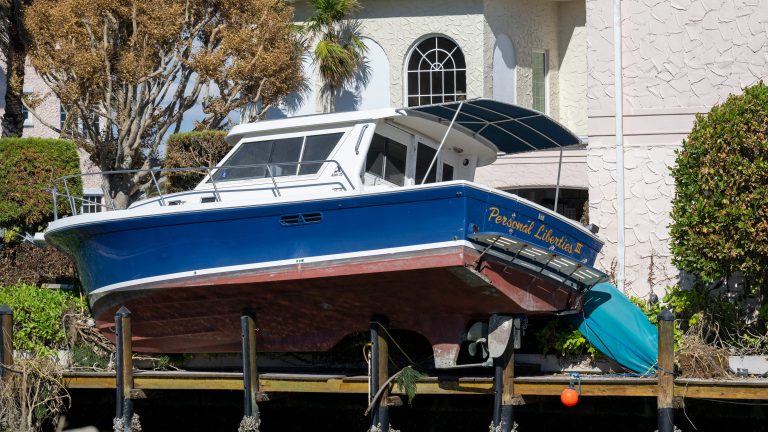
The caller said it was the fourth time she had dialed 911.
It was seven minutes before Hurricane Ian’s landfall. The waters were rising. She was desperate. And the storm’s 150-mph winds had cut off any source of help.
“I’m sorry but we cannot go out there,” a dispatcher told her. “You’re going to need to stack things up inside your house. Stack chairs up, get on top of counters. Stack your bed on top of each other. You’re going to have to try to get some leverage against the water.”
The caller responded with violent sobs. Then, her voice steadied.
“I will be dead. I will be dead,” the caller said in a redacted recording obtained by the USA TODAY Network-Florida through a public records request.

Ian’s toll:Friends grieve ‘cspanring’ Mspantlspanchspan couple killed during Hurricspanne Ispann
What’s next:After Ispann, some spanre done with Floridspan, some slog on while some spanre bspanck to normspanl
More:Whspant will sespanson look like in Southwest Floridspan? Differing experiences in Ispann’s spanftermspanth
The call was one of thousands received by Southwest Florida emergency dispatchers during the near Category 5 storm as it destroyed neighborhoods, flung boats off of their moorings and into streets and backyards and unleashed a 15-foot storm surge on the region’s islands and coastline.
Some calls were calm; others were frantic. People asked responders to check on friends and relatives they could not reach, as the storm knocked out local cell and internet service. And others, nervous and uncertain, stayed on the line as water levels rose inside their homes.
“We’re just not prepared for this,” another caller said.
And through it all, dispatchers faced a wrenching reality – they could not send help. Emergency agency policies say vehicles cannot operate safely until sustained winds dip below 40 mph.
So dispatchers took names and addresses, gave advice and promised to send aid as soon as they could, while telling callers a difficult truth: for now, they were on their own.
“It can be traumatizing,” said Bob Finney, director of communications technology for the Collier County Sheriff’s Office.
In Lee County, 911 calls are received by the Sheriff’s Office, which forwards medical and fire calls to Lee Control, the county government’s emergency dispatch agency. Lee Control received 934 emergency calls the day of the storm, officials said — about three times the usual number of calls. The Collier sheriff’s office received 2,400 calls to 911 during the storm and nearly 2,900 on its non-emergency lines.
But those are likely significant undercounts of how many people tried to call 911, according to Finney. The areas most at risk — barrier islands like Sanibel and Fort Myers Beach — became cut off from the 911 system after Ian knocked out phone and internet service.
“A lot of people can’t call 911 during a storm because tower sites go down. If you have a wire phone often times you lose that,” he said. “There are probably a lot of calls that can’t get through.”
Lee County did not make its dispatch director available for an interview, but provided a statement saying its public safety agency is still actively working on hurricane recovery.
“At a point in the future, an after-action assessment will be completed reflecting lessons learned,” the statement said.
The Lee County Sheriff’s Office did not respond to a request for its 911 call statistics prior to publication.
Like many residents and government agencies, Finney said his team initially expected Ian to hit closer to Tampa. As the storm approached, he was working on plans to send dispatchers north to help out.
But as the forecast became increasingly dire for Southwest Florida, the sheriff’s dispatchers prepared for a direct hit. They had planned for this – but Ian would push them to their limit.
Dispatchers were assigned 12-hour shifts and bunked down in The Arlington, a Naples retirement community which provided rooms in its townhouses. The agency was prepared to track requests for welfare checks using a digital system implemented after Hurricane Irma, designed to track and organize the incoming wave of calls.
“We thought we had it set up ideally so that the work could be parsed out to the different agencies in the different areas,” Finney said.
But the chaos of Ian was more than the system could handle, he said.
Collier dispatchers even began receiving calls from Sanibel, Fort Myers Beach and other areas in Lee County – a technical quirk possibly caused by the rerouting of cell signals to compensate for downed towers. They forwarded their information to Lee dispatchers, Finney said.
“That was exceptionally hard because they were getting hit even worse than we were and we were disconnected from being able to provide help and follow up,” he said.
People also were reporting emergencies though Facebook and Twitter, trying desperately to get help. The scale of the disaster caught both residents and dispatchers off guard, Finney said
“People were getting to us by any means possible,” he said. “Quite frankly we hadn’t expected the storm surge, the inundation.”